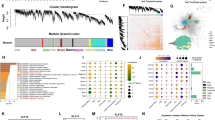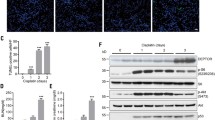Abstract
Measurable indicators of renal injury are required for the assessment of kidney function after toxicant challenge. In our previous study, pleckstrin homology-like domain, family A, member 3 (Phlda3) was a most greatly up-regulated molecule downstream from p53, culminating with kidney tubular injury. This study investigated the positive feedforward effect of Phlda3 on p53 in an effort to explain the largest increase of Phlda3 in injured tubules and the potential of its urine excretion. qRT-PCR assays confirmed a rapid and substantial increase in Phlda3 messenger RNA (mRNA) in the kidney cortex of mice treated with a single dose of cisplatin. Cisplatin overexpression of Phlda3 was verified by gene set analyses of three different microarray databases. In the immunohistochemistry, Phlda3 staining intensities were augmented in the tubules as kidney injury worsened. Moreover, the urinary content of Phlda3 was increased after cisplatin treatment, as were those of other kidney injury markers (Kim-1 and Timp-1). By contrast, cisplatin failed to increase Phlda3 mRNA in the liver despite hepatocyte necrosis and ensuing increases in serum transaminase activities. In NRK52E tubular cells, siRNA knockdown of Phlda3 enhanced the ability of cisplatin to increase p-Mdm2 presumably via Akt, enforcing the interaction between Mdm2 and p53. Consistently, a deficiency in Phlda3 abrogated p53 increase by cisplatin, indicating that Phlda3 promotes p53 accumulation. Phlda3 overexpression had the opposite effect. In addition, treatment with cyclosporine A or CdCl2, other nephrotoxicants, increased Phlda3 mRNA and protein levels in NRK52E cells, as did cisplatin treatment. Overall, Phlda3 may cause p53 accumulation through a feedforward pathway, facilitating tubular injury and its urine excretion.




Similar content being viewed by others
Abbreviations
- ALT:
-
Alanine aminotransferase
- AST:
-
Aspartate aminotransferase
- BUN:
-
Blood urea nitrogen
- Kim-1:
-
Kidney injury molecule 1
- NAG:
-
N-acetyl-beta-d-glucosaminidase
- Phlda3:
-
Pleckstrin homology-like domain
- family A:
-
Member 3
- qRT-PCR:
-
Quantitative real-time polymerase chain reaction
- SCr:
-
Serum creatinine
- Timp-1:
-
TIMP metallopeptidase inhibitor 1
References
Amin RP, Vickers AE, Sistare F, Thompson KL, Roman RJ, Lawton M, et al. Identification of putative gene based markers of renal toxicity. Environ Health Perspect. 2004;112:465–79.
Brenner BM, Falchuk KH, Keimowitz RI, Berliner RW. The relationship between peritubular capillary protein concentration and fluid reabsorption by the renal proximal tubule. J Clin Invest. 1969;48:1519–31.
Cavalli F, Tschopp L, Sonntag RW, Zimmermann A. A case of liver toxicity following cis-dichlorodiammineplatinum(II) treatment. Cancer Treat Rep. 1978;62:2125–6.
Cersosimo RJ. Hepatotoxicity associated with cisplatin chemotherapy. Ann Pharmacother. 1993;27:438–41.
Ciarimboli G, Ludwig T, Lang D, Pavenstädt H, Koepsell H, Piechota HJ, et al. Cisplatin nephrotoxicity is critically mediated via the human organic cation transporter 2. Am J Pathol. 2005;167:1477–84.
Datta K, Franke TF, Chan TO, Makris A, Yang SI, Kaplan DR, et al. AH/PH domain-mediated interaction between Akt molecules and its potential role in Akt regulation. Mol Cell Biol. 1995;15:2304–10.
Devarajan P. Emerging urinary biomarkers in the diagnosis of acute kidney injury. Expert Opin Med Diagn. 2008;2:387–98.
Dieterle F, Sistare F, Goodsaid F, Papaluca M, Ozer JS, Webb CP, et al. Renal biomarker qualification submission: a dialog between the FDA-EMEA and predictive safety testing consortium. Nat Biotechnol. 2010;28:455–62.
Fielden MR, Eynon BP, Natsoulis G, Jarnagin K, Banas D, Kolaja KL. A gene expression signature that predicts the future onset of drug-induced renal tubular toxicity. Toxicol Pathol. 2005;33:675–83.
Fox BC, Devonshire AS, Schutte ME, Foy CA, Minguez J, Przyborski S, et al. Validation of reference gene stability for APAP hepatotoxicity studies in different in vitro systems and identification of novel potential toxicity biomarkers. Toxicol In Vitro. 2010;24:1962–70.
Jiang M, Yi X, Hsu S, Wang CY, Dong Z. Role of p53 in cisplatin-induced tubular cell apoptosis: dependence on p53 transcriptional activity. Am J Physiol Ren Physiol. 2004;287:F1140–7.
Kawase T, Ohki R, Shibata T, Tsutsumi S, Kamimura N, Inazawa J, et al. PH domain-only protein PHLDA3 is a p53-regulated repressor of Akt. Cell. 2009;136:535–50.
Kim SG. Kidney: Toxicological assessment. 1st ed. London: CRC Press; 2013.
Lee CG, Kim JG, Kim HJ, Kwon HK, Cho IJ, Choi DW, et al. Discovery of an integrative network of microRNAs and transcriptomics changes for acute kidney injury. Kidney Int. 2014a;86:943–53.
Lee CG, Kim YW, Kim EH, Meng Z, Huang W, Hwang SJ, et al. Farnesoid X receptor protects hepatocytes from injury by repressing miR-199a-3p, which increases levels of LKB1. Gastroenterology. 2012;142:1206–17.
Lee YK, Park EY, Kim S, Son JY, Kim TH, Kang WG, et al. Evaluation of cadmium-induced nephrotoxicity using urinary metabolomic profiles in Sprague–Dawley male rats. J Toxicol Environ Health A. 2014b;77:1384–98.
Mayo LD, The DDB, PTEN. Mdm2, p53 tumor suppressor-oncoprotein network. Trends Biochem Sci. 2002;27:462–7.
Molitoris BA, Dagher PC, Sandoval RM, Campos SB, Ashush H, Fridman E, et al. siRNA targeted to p53 attenuates ischemic and cisplatin-induced acute kidney injury. J Am Soc Nephrol. 2009;20:1754–64.
Ogawara Y, Kishishita S, Obata T, Isazawa Y, Suzuki T, et al. Akt enhances Mdm2-mediated ubiquitination and degradation of p53. J Biol Chem. 2002;277:21843–50.
O’Keefe K, Li H, Zhang Y. Nucleocytoplasmic shuttling of p53 is essential for MDM2-mediated cytoplasmic degradation but not ubiquitination. Mol Cell Biol. 2003;23:6396–405.
Pollera CF, Ameglio F, Nardi M, Vitelli G, Marolla P. Cisplatin-induced hepatic toxicity. J Clin Oncol. 1987;5:318–9.
Saxena A, Morozov P, Frank D, Musalo R, Lemmon MA, et al. Phosphoinositide binding by the pleckstrin homology domains of Ipl and Tih1. J Biol Chem. 2002;277:49935–4944.
Supavekin S, Zhang W, Kucherlapati R, Kaskel FJ, Moore LC, Devarajan P. Differential gene expression following early renal ischemia/reperfusion. Kidney Int. 2003;63:1714–24.
Togashi Y, Sakaguchi Y, Miyamoto M, Miyamoto Y. Urinary cystatin C as a biomarker for acute kidney injury and its immunohistochemical localization in kidney in the CDDP-treated rats. Exp Toxicol Pathol. 2012;64:797–805.
Tokumoto M, Fujiwara Y, Shimada A, Hasegawa T, Seko Y, Nagase H, et al. Cadmium toxicity is caused by accumulation of p53 through the down-regulation of Ube2d family genes in vitro and in vivo. J Toxicol Sci. 2011;36:191–200.
Wei Q, Dong G, Yang T, Megyesi J, Price PM, Dong Z. Activation and involvement of p53 in cisplatin-induced nephrotoxicity. Am J Physiol Ren Physiol. 2007;293:F1282–91.
Vaidya VS, Ferguson MA, Bonventre JV. Biomarkers of acute kidney injury. Annu Rev Pharmacol Toxicol. 2008;48:463–93.
Vaidya VS, Ramirez V, Ichimura T, Bobadilla NA, Bonventre JV. Urinary kidney injury molecule-1: a sensitive quantitative biomarker for early detection of kidney tubular injury. Am J Physiol Ren Physiol. 2005;290:F517–29.
Acknowledgments
This work was supported by a grant [10182KFDA992] from Korea Food & Drug Administration in 2010–2012. The authors wish to thank Dr. Se Jin Hwang in the College of Medicine, Hanyang University, for histological evaluation.
Conflict of interest
The authors declare that they have no conflict of interest.
Author contributions
The overall study was conceived and designed by CGL and SGK; CGL analyzed data; AM and HSK contributed reagents or analysis tools; CGL and SGK wrote the paper.
Author information
Authors and Affiliations
Corresponding author
Electronic supplementary material
Below is the link to the electronic supplementary material.
Supplementary Figure 1
Immunoprecipitation and immunoblotting analysis for Mdm2 and p53. NRK52E cells were treated with 30 μM cisplatin for the indicated times. (JPEG 55 kb)
Rights and permissions
About this article
Cite this article
Lee, C.G., Kang, Y.J., Kim, H.S. et al. Phlda3, a urine-detectable protein, causes p53 accumulation in renal tubular cells injured by cisplatin. Cell Biol Toxicol 31, 121–130 (2015). https://doi.org/10.1007/s10565-015-9299-4
Received:
Accepted:
Published:
Issue Date:
DOI: https://doi.org/10.1007/s10565-015-9299-4




